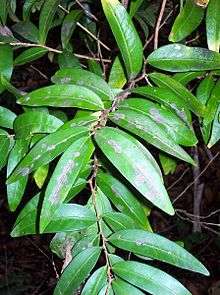Hedraianthera
| Hedraianthera | |
|---|---|
 | |
| Scientific classification | |
| Kingdom: | Plantae |
| (unranked): | Angiosperms |
| (unranked): | Eudicots |
| (unranked): | Rosids |
| Order: | Celastrales |
| Family: | Celastraceae |
| Genus: | Hedraianthera F.Muell. |
| Species: | H. porphyropetala |
| Binomial name | |
| Hedraianthera porphyropetala F.Muell.[1] | |
Hedraianthera is a genus of a sole recognised species of shrubs or small trees found only in Australia. The genus and species constitutes part of the Bittersweet plant family Celastraceae.[1][2]
The species Hedraianthera porphyropetala grows naturally in eastern Australia in littoral or sub-tropical rainforest north from Ballina, New South Wales to Cooktown in tropical north eastern Queensland. They grow in gullies or rocky slopes on shallow soils, sometimes enhanced by basalt.[3][4][5]
The generic name Hedraianthera is from Greek, it refers to the flower anthers without stalks. The specific epithet porphyropetala is also from Greek, it alludes to the attractive deep purple coloured flowers, although the species definition includes plants which have different coloured flowers such as green. They are an unusually southern example of ramiflory.
Previously several publications provided informal scientific descriptions of another species under the provisional scientific name Hedraianthera sp. Mossman (V.K.Moriarty 2557) Qld Herbarium.[6][7][8] In a 2012 published Celastraceae genetics study this provisionally named species was reassigned to the genus Brassiantha and formally scientifically described under the new name Brassiantha hedraiantheroides, after its likeness to Hedraianthera.[6][9] Though still relatively closely related the two species were found to be constitutive of different genera. H. porphyropetala here, again became the only known species in this genus and now Brassiantha constituted not only by the one, but instead by only the two known species, this forementioned B. hedraiantheroides and the New Guinean B. pentamera. B. hedraiantheroides grows naturally only (endemic) in a restricted area of the wet tropics region of north eastern Queensland, Australia. It grows as an understory shrub or small tree in rainforests and sclerophyll forests, from an altitudinal range near sea level to 600 m (2,000 ft).[6][7]
References
- 1 2 "Hedraianthera%". Australian Plant Name Index (APNI), Integrated Botanical Information System (IBIS) database (listing by % wildcard matching of all taxa relevant to Australia). Centre for Plant Biodiversity Research, Australian Government. Retrieved 21 June 2013.
- ↑ Hyland, B. P. M.; Whiffin, T.; Zich, F. A.; et al. (Dec 2010). "Factsheet – Celastraceae". Australian Tropical Rainforest Plants. Edition 6.1, online version [RFK 6.1]. Cairns, Australia: Commonwealth Scientific and Industrial Research Organisation (CSIRO), through its Division of Plant Industry; the Centre for Australian National Biodiversity Research; the Australian Tropical Herbarium, James Cook University. Retrieved 13 Mar 2013.
- ↑ Hyland, B. P. M.; Whiffin, T.; Zich, F. A.; et al. (Dec 2010). "Factsheet – Hedraianthera porphyropetala". Australian Tropical Rainforest Plants. Edition 6.1, online version [RFK 6.1]. Cairns, Australia: Commonwealth Scientific and Industrial Research Organisation (CSIRO), through its Division of Plant Industry; the Centre for Australian National Biodiversity Research; the Australian Tropical Herbarium, James Cook University. Retrieved 13 Mar 2013.
- ↑ James, T. A. (2001). "Hedraianthera porphyropetala – New South Wales Flora Online". PlantNET – The Plant Information Network System. 2.0. Sydney, Australia: The Royal Botanic Gardens and Domain Trust. Retrieved 13 Mar 2013.
- ↑ Floyd, A.G., Rainforest Trees of Mainland South-eastern Australia, Inkata Press 2008, ISBN 978-0-9589436-7-3 page 101
- 1 2 3 Simmons, Mark P.; McKenna, Miles J.; Bacon, Christine D.; Yakobson, Kendra; Cappa, Jennifer J.; Archer, Robert H.; Ford, Andrew J. (Jan 2012). "Phylogeny of Celastraceae tribe Euonymeae inferred from morphological characters and nuclear and plastid genes". Molecular Phylogenetics and Evolution. 62 (1): 9–20. doi:10.1016/j.ympev.2011.08.022. ISSN 1055-7903. Retrieved 19 Apr 2013.
- 1 2 Hyland, B. P. M.; Whiffin, T.; Zich, F. A.; et al. (Dec 2010). "Factsheet – Hedraianthera sp. Mossman (V.K.Moriarty 2557) Qld Herbarium". Australian Tropical Rainforest Plants. Edition 6.1, online version [RFK 6.1]. Cairns, Australia: Commonwealth Scientific and Industrial Research Organisation (CSIRO), through its Division of Plant Industry; the Centre for Australian National Biodiversity Research; the Australian Tropical Herbarium, James Cook University. Retrieved 13 Mar 2013.
- ↑ Bostock, P. D.; Holland, A. E., eds. (2010). Census of the Queensland Flora 2010. Brisbane: Queensland Herbarium, Department of Environment and Resource Management. p. 39. Retrieved 13 Mar 2013.
- ↑ "Brassiantha hedraiantheroides A.J.Ford". Australian Plant Name Index (APNI), IBIS database. Centre for Plant Biodiversity Research, Australian Government. Retrieved 18 April 2013.